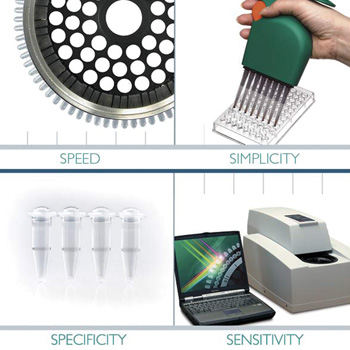Solving Today’s Business Problems with Rapid Testing Innovations

Food manufacturers may be under more pressure now than at any other time in recent history. In the face of fluctuating global markets, tighter operating budgets, thinner profit margins and continued regulatory scrutiny, organizations are looking very hard for innovations in technology that will enable them to operate more efficiently and remain competitive. Frequently laboratory, quality assurance (QA) and operations staffs have found value in working together to find solutions to business challenges, and ultimately, ways to improve the company’s bottom line.
Many companies have turned to recent innovations in rapid testing for solutions. A new testing platform that has proven an effective solution to a growing number of food manufacturers is Assurance GDS (genetic detection system) from BioControl. Assurance GDSTM combines the latest advancements in food microbiology and molecular science to provide an unprecedented level of speed, ease-of-use and accuracy in pathogen detection. In fact, Assurance GDS is the first DNA-based system capable of providing results for all major pathogens, Salmonella, E. coli O157:H7, Listeria monocytogenes and Listeria spp. in 24 hours or less, without compromising accuracy or ease of use.
A fast turnaround time of test results for product and environmental samples is critical to most food manufacturers. In addition to increasing lab efficiency, faster test results can present an opportunity to decrease product holding costs by releasing product sooner. In the case of environmental samples, faster results can result in significant savings in raw materials and finished product if contamination is detected and corrective actions implemented sooner.
A key to obtaining faster test results is in the selection of test method, and more specifically the enrichment and sample preparation of the method. One of the challenges in pathogen testing is to provide for the highest amount of target organism present in the sample while simultaneously suppressing the presence of non-target organisms that could potentially interfere with the detection of the target. Antibody-based methods rely on their enrichment medias to accomplish this. Most PCR methods require additional dilution of the sample to decrease the concentration of inhibitors, resulting in very small volumes of enriched sample, as low as 1.25 µL and 10 µL being analyzed. This in turn requires longer enrichment periods to arrive at sufficient organism growth for reliable detection.
In contrast Assurance GDS uses a proprietary immunomagnetic separation (IMS) step to capture and concentrate target organisms which allows for 10 times more sample volume to be analyzed and provides for shorter enrichment times and elimination of traditional multi-step enrichment programs without sacrificing sensitivity or specificity. As a result, users can obtain results for E. coli O157:H7 in only eight hours as opposed to 12-18 hours of other methods, and in less than 24 hours for Salm-onella, Listeria and L. mono compared to 48+ hours required by other methods.
Advances in Genetic Detection
Another area that has seen recent innovation in rapid test methods and can have a significant impact on a manufacturer’s operation is test accuracy, sometimes referred to as inclusivity/exclusivity. This is the ability of a method to detect all strains of the target organism without missing any (inclusivity) while not detecting any non-target organisms that may be present in the sample (exclusivity). Methods that utilize DNA-based technologies have introduced a new level of accuracy that is not possible in antibody-based methods. However, even among PCR methods there are differences in accuracy.
Assurance GDS incorporates two levels of molecular specificity to ensure accuracy; one is a highly specific primer that must match the target’s DNA sequence to initiate the amplification or copying process. The second is a highly specific molecular probe containing a DNA sequence that must match the target DNA to produce a fluorescence signal for detection. Other PCR systems use only primers for specificity. They may also use a non-specific dye, such a sybr green, which attaches to any DNA present not just the target. These systems must perform a melt-curve analysis to differentiate between target and other amplified material, which can be time-consuming and open to subjective interpretation.
Food manufacturers benefit from greater accuracy of their testing method by having fewer false positives or indeterminates, both of which have a significant impact on operations in terms of cost and labor. Cost goes well beyond laboratory expenses of confirming or re-running samples in the case of indeterminates. One must consider the increased holding costs and even the opportunity cost of a shortened shelf life for fresh products.
The advantages of speed and specificity that Assurance GDS offers over other rapid testing methods can provide food processors with solutions to address specific business issues and positively affect their bottom line. Whe-ther screening for pathogens in-house or sending to a commercial lab, accurate and timely test results can be the difference between success and failure.
biocontrolsys.com
Looking for a reprint of this article?
From high-res PDFs to custom plaques, order your copy today!





